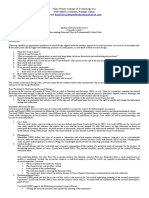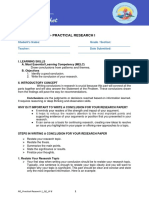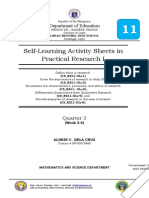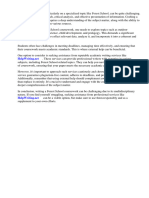Lesson 6-7 - (Draw Conclusions From Patterns and Themes) (Formulating Recommendations Based On Conclusions)
Uploaded by
Mary Rose AlegriaLesson 6-7 - (Draw Conclusions From Patterns and Themes) (Formulating Recommendations Based On Conclusions)
Uploaded by
Mary Rose AlegrialOMoARcPSD|9354437
11
Practical Research 1
Quarter 4 – Module 7
Week 7 – 8
Reporting and
Sharing the
Findings
Downloaded by Mary Rose Alegria (maryrosealegria.06@gmail.com)
lOMoARcPSD|9354437
Lesson
Draws Conclusions from
1 Patterns and Themes
A conclusion is like the final chord in a song. It is the section in a
research report where the researcher finds a chance of leaving a lasting impression.
It usually includes a comprehensive summary of the findings. The key points are
highlighted briefly based on the analysis or results of the study. Important
implications applied to practice are specifically noted. Furthermore, the conclusion
points out to what were factually learned from the inquiry. This section elucidates o
drawing and writing the conclusion of the research paper.
You have to state your conclusion in clear, simple language. No new
information should be added to the conclusion. It is in the conclusion where you
describe the value of your research.
What’s In
Directions: Look at each acronym below. Formulate your own
description/meaning of qualitative research. It could be a word, phrase or a sentence.
Q-
U-
A-
L-
I-
T-
A-
T-
I-
V-
E-
11
Downloaded by Mary Rose Alegria (maryrosealegria.06@gmail.com)
lOMoARcPSD|9354437
What is It
Summary
Wrap up/summarize the study’s argument by:
1. Writing a brief recapitulation of Chapters 1 and 2 by restating the objectives
and specific problems of the study and methodology; and
2. Presenting salient findings /results based on the formulated specific
problems.
Findings
In one-to – one correspondence and in numbered format, indicate the findings
of the study. One sentence will do for each problem.
Conclusions
Characteristics of Conclusions
1. Conclusions are references, deductions, abstractions, implications,
interpretations, general statements and/or generalizations based upon
findings.
2. Conclusions should appropriately answer the specific questions raised at the
beginning of the investigation in the order they are given under the statement
of the problem.
3. Conclusion should point out what were factually learned from the inquiry.
Purposes of a Conclusion
Conclusion does the following:
1. Stress the importance of thesis statement.
2. Give the written work a sense of completeness
3. Leave a final impression on the reader
4. Demonstrates a good organization
13
Downloaded by Mary Rose Alegria (maryrosealegria.06@gmail.com)
lOMoARcPSD|9354437
Strategies in Writing Conclusions
• Echoing your introduction, or simply reiterate or link ideas expressed in the
other sections of research.
• Conclusion should be formulated concisely that is, brief and short, yet they
convey all necessary information resulting from the investigation.
• A conclusion must state generalization based on the findings.
• Observe “one finding: one conclusion.” Match the findings with the
conclusions. Use numbers in the format.
• Flexibility may be considered in making conclusions on a one-to-one
correspondence with the specific problems and the findings as some or all
variable can be subsumed in one paragraph.
The process of drawing conclusions begin as early you code your data. As
you review and code your data, begin to form ideas about the important
phenomena they indicate as well generate the propositions about them
and the relationships among them. Once the data are coded, you will look
over the propositions to write your conclusions.
In drawing and verifying conclusions from qualitative data among the
most useful in the analysis are:
• Noting patterns and theme. These are recurring themes which put together
many separate pieces of data. The data may be grouped together according to
theme. It however happen that evidence, may be applicable to one or more
themes.
• Making contrasts and comparisons. Comparison is a classic way to test a
conclusion. The responses gathered form the parents, students, teachers and
other groups can be compared and contrasted so that the differences can be
noted. When conflicting information comes up, then you can refer to the
sources of the different data.
• Clustering. The process refers to the grouping of data, then conceptualizing
information that has similar patterns or characteristics. It is called
categorizing because the steps must be taken to ensure that other information
are considered or included.
• Counting. Qualitative research is basically descriptive and goes beyond how
much something to describe the subject or topic under investigation. However,
the number of time something occurs or is reported tells something about how
important or how significant an item is.
• Avoid using phrases like “in conclusion”, “in summary” and “in closing”. The
se expressions can be useful and welcome in oral presentations.
14
Downloaded by Mary Rose Alegria (maryrosealegria.06@gmail.com)
lOMoARcPSD|9354437
Formulating Recommendations Based on Conclusions
Why write a recommendation
The reader is looking for insightful comments to demonstrate that you have
been engaged with your research, that you understand your findings and that
you gained knowledge form the experience of conducting your research.
How to write recommendations
The following should be considered in writing recommendations.
• Brief- write concisely; any reasons for recommendation should only be given
if necessary.
• Clear- do not ambiguous as to how the recommendation will be implemented
• Precise- vague recommendations usually result from insufficient research
analysis.
• They must be logical by making sure that they flow sensibly from the
conclusion
• It is also important to consider the different levels within your set of
recommendations such as a) for academic, b) for the policymakers, c) for
practitioners, and d) for the training/education.
• Point out direction/s for future investigation
• Cite also a recommendation that can help your field of study, or strand.
Example 1
Summary
The qualitative study, which made use of the case study design focuses on the
reasons of students dropping out from school and the corresponding
experiences after leaving school.
It utilized the interview, method to gather relevant data from respondents who
dropped out from school. The students were selected using the snow ball
technique.
It followed Collazi’s Method and applied Cool and Warm Analyses to bring out
the relevant themes. A synthesizing diagram was crafted to this effect.
15
Downloaded by Mary Rose Alegria (maryrosealegria.06@gmail.com)
lOMoARcPSD|9354437
Findings
The following are salient findings of the study:
1. The period of dropping out was during Transition Period (Elementary- High
School) or Duration of High School.
2. The reasons for dropping out are Personal-Familial Issues, Socio-Economic
Issues and School-Related Issues.
3. The drop-out students suffers from unfavourable conditions as a result of
their decision.
Conclusion
There are three interdependent reasons why students drop out: Personal-
Familial Issues, Socio-Economic Issues, and School-related Issues. Students
who dropped out experience unfavourable conditions which lead them to
regret their decisions of leaving school.
Recommendations
The researchers recommend the following:
1. The results of the study should be studied by the schools of Pangasinan
Division II as basis for formulating an action plan or an intervention
mechanism.
2. Guidance Counselors should focus on the cases of these drop-out students by
giving orientation to students beginning in Grade 7 and should continue
throughout the high school years.
3. Parents and even teachers should motivate more the students to keep on going
to school and finish it
4. Parents should improve their parental support to their children.
5. The school should intensify the conduct of anti-bullying programs
6. Scholarships and allowances should be provided to those who cannot afford
to go to school.
7. School s should orient the students about early pregnancy.
8. Guidance Counselors and teachers should coordinate in helping the students
understand better their situations
9. Schools should revisit policies on inclusive education.
16
Downloaded by Mary Rose Alegria (maryrosealegria.06@gmail.com)
lOMoARcPSD|9354437
Example 2
Summary
The qualitative study which made use of phenomenological research design,
focuses on the challenges of physicians during the disease treatment.
It utilized the interview method to gather relevant data from the respondents.
The physicians were selected using the homogenous and purposive sampling.
It followed Kelly grid method and applied cool analysis to bring out the
relevant themes. A synthesizing diagram was crafted to this effect.
Findings
The following are the salient findings of the study:
1. The challenges of physicians are managerial and relational. The managerial
challenges of physicians include non-compliant patients and toxic cases. the
relational challenges of physicians include disclosure adversity and peer
asperity
Insights/Conclusion
The researchers learned that becoming a physician entails challenges for it r
equires a lot of effort, time, knowledge, patience and understanding. They are
in hard position because they sacrifice these things to help to help those in
need. Physicians have t deal with life and death and a single mistake could
ruin the trust they earned. Despite these challenges, they continuously
educate themselves to improve not only as a physician but also as a person.
Recommendations
The researchers recommend the following:
1. The physicians must always check their patients in taking prescribed
medicine.
2. Physicians must continuously and significantly remind their patients that
their cooperation is necessary for a successful and effective treatment.
3. The physicians must regularly educate themselves in order to be able to tackle
different cases.
4. The physicians must observe and ensure camaraderie and ethics between
themselves for better collaboration in meeting the needs of patients.
17
Downloaded by Mary Rose Alegria (maryrosealegria.06@gmail.com)
You might also like
- Practical Research 1: Quarter 3, LAS 6: Synthesizing Information and Writing Coherent Literature ReviewNo ratings yetPractical Research 1: Quarter 3, LAS 6: Synthesizing Information and Writing Coherent Literature Review8 pages
- Analyzing The Meaning of The Data and Drawing100% (1)Analyzing The Meaning of The Data and Drawing12 pages
- Practical Research 1 Gathering Your Data: Quarter 4 - Week 4No ratings yetPractical Research 1 Gathering Your Data: Quarter 4 - Week 42 pages
- Guidelines in Making Conclusions and RecommendationsNo ratings yetGuidelines in Making Conclusions and Recommendations33 pages
- Department of Education: Republic of The PhilippinesNo ratings yetDepartment of Education: Republic of The Philippines5 pages
- Drawing Conclusions From Patterns and ThemesNo ratings yetDrawing Conclusions From Patterns and Themes24 pages
- The Importance of Research in Daily LifeNo ratings yetThe Importance of Research in Daily Life22 pages
- Research in Daily Life 1: Qualitative Research Designs, Sample, and Data Collection and Analysis ProceduresNo ratings yetResearch in Daily Life 1: Qualitative Research Designs, Sample, and Data Collection and Analysis Procedures14 pages
- Chapter 4 Analyzing The Meaning of The Data and Drawing Conclusions 1No ratings yetChapter 4 Analyzing The Meaning of The Data and Drawing Conclusions 134 pages
- 6 Reviewing and Citing The Related LiteratureNo ratings yet6 Reviewing and Citing The Related Literature4 pages
- FINAL PPT PR1!11!12 UNIT 2 LESSON 2 Types of Qualitative ResearchNo ratings yetFINAL PPT PR1!11!12 UNIT 2 LESSON 2 Types of Qualitative Research26 pages
- Infers and Explain Patterns and Themes From Data100% (1)Infers and Explain Patterns and Themes From Data21 pages
- Self-Learning Kit: Research Design and Sampling Practical Research 1100% (1)Self-Learning Kit: Research Design and Sampling Practical Research 116 pages
- Senior High School-PRACTICAL RESEARCH I: Draw Conclusions From Patterns and ThemesNo ratings yetSenior High School-PRACTICAL RESEARCH I: Draw Conclusions From Patterns and Themes5 pages
- ACTIVITY SHEET PR1 WEEK 14 Q4 Finding Answers Through Data CollectionNo ratings yetACTIVITY SHEET PR1 WEEK 14 Q4 Finding Answers Through Data Collection4 pages
- MODULE4-Designs A Research Used in Daily LifeNo ratings yetMODULE4-Designs A Research Used in Daily Life14 pages
- Designing Research Project Quarter 3: Week 3 & 4: Module 2: Practical Research INo ratings yetDesigning Research Project Quarter 3: Week 3 & 4: Module 2: Practical Research I25 pages
- Signed Off - Practical Research 2 G12 - 2ndsem - Mod2 - Finding Answers Through Data Collection - v3 PDFNo ratings yetSigned Off - Practical Research 2 G12 - 2ndsem - Mod2 - Finding Answers Through Data Collection - v3 PDF10 pages
- LAS in PRACTICAL RESEARCH 1 QUARTER 3 WEEK 3-4No ratings yetLAS in PRACTICAL RESEARCH 1 QUARTER 3 WEEK 3-410 pages
- Practical Research 1 - Q 1 - Mod 2 - Qualitative Research and Its Importance To Daily Life - v5No ratings yetPractical Research 1 - Q 1 - Mod 2 - Qualitative Research and Its Importance To Daily Life - v533 pages
- Collecting Data Through Observation, Interview and Other Method100% (1)Collecting Data Through Observation, Interview and Other Method2 pages
- Senior High School Department: Practical Research 1No ratings yetSenior High School Department: Practical Research 17 pages
- LAS in PRACTICAL RESEARCH 2 QUARTER 2 Week 3-4No ratings yetLAS in PRACTICAL RESEARCH 2 QUARTER 2 Week 3-417 pages
- Formulating The Introduction of A Research PaperNo ratings yetFormulating The Introduction of A Research Paper9 pages
- Practical Research 1 Practical Research 1No ratings yetPractical Research 1 Practical Research 111 pages
- LAS in PRACTICAL RESEARCH 1 QUARTER 3 WEEK 5-6No ratings yetLAS in PRACTICAL RESEARCH 1 QUARTER 3 WEEK 5-617 pages
- Practical Research 1 Research in Different Areas of Interest MELC5 LAS100% (2)Practical Research 1 Research in Different Areas of Interest MELC5 LAS8 pages
- Applied - Practical Research1 - Q1 - M10-Providing The Justifications Reasons For Conducting The ResearchNo ratings yetApplied - Practical Research1 - Q1 - M10-Providing The Justifications Reasons For Conducting The Research10 pages
- Practical Research 1: Quarter 4 - Module 24.1 Collecting Data Through Observation100% (1)Practical Research 1: Quarter 4 - Module 24.1 Collecting Data Through Observation15 pages
- Qualitative Research (Research in Daily Life 1)100% (1)Qualitative Research (Research in Daily Life 1)24 pages
- Lesson 1 - Issues in Media and InformationNo ratings yetLesson 1 - Issues in Media and Information21 pages
- Lesson 3 - Data Collection and Analysis ProcedureNo ratings yetLesson 3 - Data Collection and Analysis Procedure23 pages
- DLP Preparing The Initial Report and Finding 1No ratings yetDLP Preparing The Initial Report and Finding 19 pages
- Lesson 6 - Information and Visual InformationNo ratings yetLesson 6 - Information and Visual Information14 pages
- GRADE - 12 - MARCH - 15 - CLMD F069 Lesson Exemplars For Catch Up Fridays1No ratings yetGRADE - 12 - MARCH - 15 - CLMD F069 Lesson Exemplars For Catch Up Fridays14 pages
- Trivia Game Fun Presentation in Black Bright Green Brutalist Cyberpunk StyleNo ratings yetTrivia Game Fun Presentation in Black Bright Green Brutalist Cyberpunk Style23 pages
- Lesson Plan in Writing A Research Paper Grade 10No ratings yetLesson Plan in Writing A Research Paper Grade 1016 pages
- 2022 - 2023 Academic Calendar NUC Programmes ScheduleNo ratings yet2022 - 2023 Academic Calendar NUC Programmes Schedule2 pages
- Pandangan Ibu Bapa Dalam Pemberian Vaksin PICKid Pandangan Dari SudutNo ratings yetPandangan Ibu Bapa Dalam Pemberian Vaksin PICKid Pandangan Dari Sudut613 pages
- 2015 Johnson, L.L. (2015) - Rethinking Parental Involvement A Critical Review of The Literature.No ratings yet2015 Johnson, L.L. (2015) - Rethinking Parental Involvement A Critical Review of The Literature.14 pages
- Gullberg_Indefrey_Lang_Hist_Quest_Eng_2003No ratings yetGullberg_Indefrey_Lang_Hist_Quest_Eng_20034 pages
- Coventry university_acceptance_2025_03_05No ratings yetCoventry university_acceptance_2025_03_056 pages
- Practicumproposal Christinaasiedua 4-1-23No ratings yetPracticumproposal Christinaasiedua 4-1-234 pages
- Faculty of Management Studies, University of DelhiNo ratings yetFaculty of Management Studies, University of Delhi6 pages
- MATATAG Grades 4-6 Class Program 2024-2025No ratings yetMATATAG Grades 4-6 Class Program 2024-20253 pages
- Unit 4 When'S Your Birthday ?: LESSON ONE (3,4,5) AimNo ratings yetUnit 4 When'S Your Birthday ?: LESSON ONE (3,4,5) Aim2 pages
- Australian Professional Standards For TeachersNo ratings yetAustralian Professional Standards For Teachers31 pages
- Practical Research 1: Quarter 3, LAS 6: Synthesizing Information and Writing Coherent Literature ReviewPractical Research 1: Quarter 3, LAS 6: Synthesizing Information and Writing Coherent Literature Review
- Practical Research 1 Gathering Your Data: Quarter 4 - Week 4Practical Research 1 Gathering Your Data: Quarter 4 - Week 4
- Guidelines in Making Conclusions and RecommendationsGuidelines in Making Conclusions and Recommendations
- Department of Education: Republic of The PhilippinesDepartment of Education: Republic of The Philippines
- Research in Daily Life 1: Qualitative Research Designs, Sample, and Data Collection and Analysis ProceduresResearch in Daily Life 1: Qualitative Research Designs, Sample, and Data Collection and Analysis Procedures
- Chapter 4 Analyzing The Meaning of The Data and Drawing Conclusions 1Chapter 4 Analyzing The Meaning of The Data and Drawing Conclusions 1
- FINAL PPT PR1!11!12 UNIT 2 LESSON 2 Types of Qualitative ResearchFINAL PPT PR1!11!12 UNIT 2 LESSON 2 Types of Qualitative Research
- Self-Learning Kit: Research Design and Sampling Practical Research 1Self-Learning Kit: Research Design and Sampling Practical Research 1
- Senior High School-PRACTICAL RESEARCH I: Draw Conclusions From Patterns and ThemesSenior High School-PRACTICAL RESEARCH I: Draw Conclusions From Patterns and Themes
- ACTIVITY SHEET PR1 WEEK 14 Q4 Finding Answers Through Data CollectionACTIVITY SHEET PR1 WEEK 14 Q4 Finding Answers Through Data Collection
- Designing Research Project Quarter 3: Week 3 & 4: Module 2: Practical Research IDesigning Research Project Quarter 3: Week 3 & 4: Module 2: Practical Research I
- Signed Off - Practical Research 2 G12 - 2ndsem - Mod2 - Finding Answers Through Data Collection - v3 PDFSigned Off - Practical Research 2 G12 - 2ndsem - Mod2 - Finding Answers Through Data Collection - v3 PDF
- Practical Research 1 - Q 1 - Mod 2 - Qualitative Research and Its Importance To Daily Life - v5Practical Research 1 - Q 1 - Mod 2 - Qualitative Research and Its Importance To Daily Life - v5
- Collecting Data Through Observation, Interview and Other MethodCollecting Data Through Observation, Interview and Other Method
- Senior High School Department: Practical Research 1Senior High School Department: Practical Research 1
- Practical Research 1 Research in Different Areas of Interest MELC5 LASPractical Research 1 Research in Different Areas of Interest MELC5 LAS
- Applied - Practical Research1 - Q1 - M10-Providing The Justifications Reasons For Conducting The ResearchApplied - Practical Research1 - Q1 - M10-Providing The Justifications Reasons For Conducting The Research
- Practical Research 1: Quarter 4 - Module 24.1 Collecting Data Through ObservationPractical Research 1: Quarter 4 - Module 24.1 Collecting Data Through Observation
- GRADE - 12 - MARCH - 15 - CLMD F069 Lesson Exemplars For Catch Up Fridays1GRADE - 12 - MARCH - 15 - CLMD F069 Lesson Exemplars For Catch Up Fridays1
- Trivia Game Fun Presentation in Black Bright Green Brutalist Cyberpunk StyleTrivia Game Fun Presentation in Black Bright Green Brutalist Cyberpunk Style
- 2022 - 2023 Academic Calendar NUC Programmes Schedule2022 - 2023 Academic Calendar NUC Programmes Schedule
- Pandangan Ibu Bapa Dalam Pemberian Vaksin PICKid Pandangan Dari SudutPandangan Ibu Bapa Dalam Pemberian Vaksin PICKid Pandangan Dari Sudut
- 2015 Johnson, L.L. (2015) - Rethinking Parental Involvement A Critical Review of The Literature.2015 Johnson, L.L. (2015) - Rethinking Parental Involvement A Critical Review of The Literature.
- Faculty of Management Studies, University of DelhiFaculty of Management Studies, University of Delhi
- Unit 4 When'S Your Birthday ?: LESSON ONE (3,4,5) AimUnit 4 When'S Your Birthday ?: LESSON ONE (3,4,5) Aim




















































































































